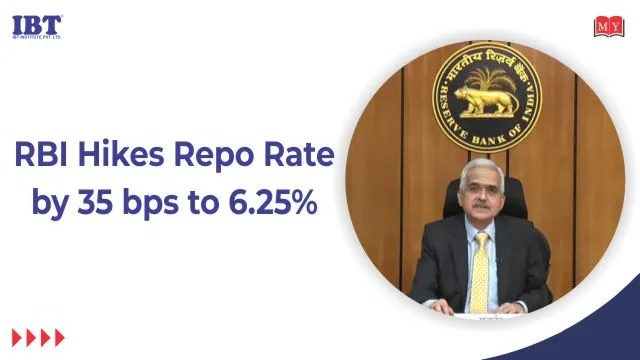
RBI Hikes repo rate by 35 bps to 6.25%
RBI increased the repo rate by 0.35% to 6.25. For FY23, the inflation rate has been estimated by RBI at 6.7%.
The decision of the Reserve Bank of India (RBI) Governor Shaktikanta Das headed six-member Monetary Policy Committee (MPC) has been announced. In the consecutive fifth hike this year, the RBI’s Monetary Policy Committee has raised the repo rate by 35 basis points (bps) to 6.25 percent with immediate effect, making loans expensive. The policy rate is now at the highest level since August 2018. The RBI has maintained policy stance at ‘withdrawal of accommodation’.
Repo Rate:
The Repo rate or repurchase rate is referred to as the rate at which the central bank (RBI) lends money to commercial banks for meeting short-term fund requirements in order to maintain liquidity and control inflation.
Functioning of Repo Rate:
Commercial banks, at times of financial crunch, seek short-term funds from the central bank of a country (RBI in the case of India) to tide over the financial crisis. For providing these funds, RBI levies interest on the amount that is lent to the commercial bank. This rate of interest is better known as the repo rate.
A Repo rate is technically a repurchase agreement in which commercial banks offer securities such as Treasury Bills to the RBI in return for short-term funds.
The banks also agree to repurchase those securities at a predetermined price.
Impact of Repo Rate in the Economy:
Repo rate is an important component of the monetary policy of the nation, and it is used to regulate the liquidity, inflation, and money supply of the nation. Additionally, repo rate levels create a direct impact on the pattern of borrowing by the banks.
In other words, in situations of increased repo rate, the banks need to pay higher interest to RBI in order to avail funds, while in terms of lower repo rate, the cost of borrowing funds is less.
The following scenarios discuss the impact of the repo rate on the economy.
1. When the inflation rate is high: At times of high inflation in the economy, the central bank (RBI) regulates the flow of money in the economy by increasing the repo rate, which results in fewer borrowings by businesses and industries. The result of this increase is slowing down the money supply and investment activities in the economy, which is instrumental in controlling the inflation rate.
2. To increase liquidity in the economy: When there is a requirement of increasing liquidity in the market, RBI eases the repo rate so that businesses can borrow money for investment purposes, which results in an increased money supply in the economy. The effect of such a step is that it becomes instrumental in the growth of the economy.
Increase in Repo Rate
1. When there is a high inflation rate in the economy, and as per RBI, the condition may further surge.
2. When there is a risk of depreciation of the currency
3. When it wants to reduce any speculations that arise in areas of foreign exchange
4. The possibility of the formation of asset bubbles as a result of an excessive amount of capital formation
Decrease in Repo Rate
1. That situation in which RBI assumes that both inflation and the fiscal deficit are well controlled and there is no unlikely possibility that a demand-led price surge will be observed.
2. When the economy is showing signs of slowing down and RBI looks to accelerate the economy by facilitating a more friendly monetary policy.
3. If the balance of payments situation is deemed to be normal by the RBI.
RBI Repo Rate: Consequently, the various rates are as under
Policy Repo Rate: 6.25% (Changed)
Standing Deposit Facility (SDF): 6.00% (Changed)
Marginal Standing Facility Rate: 6.50% (Changed)
Bank Rate: 6.50% (Changed)
Fixed Reverse Repo Rate: 3.35%
Cash Reserve Ratio (CRR): 4.50%
Statutory Liquidity Ratio (SLR): 18.00%
 4.5/5
4.5/5








